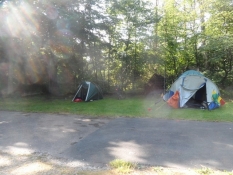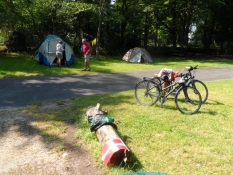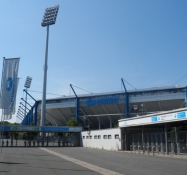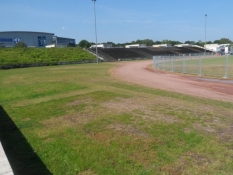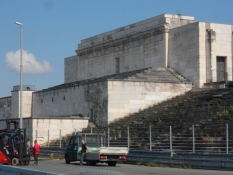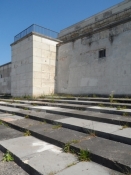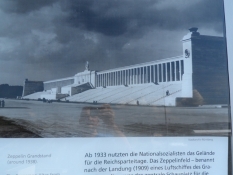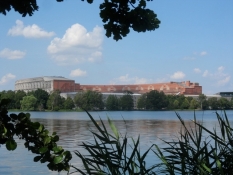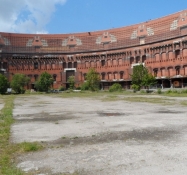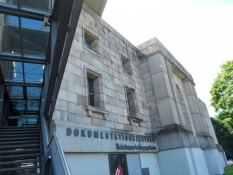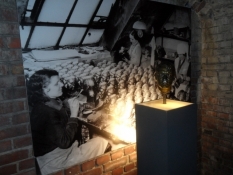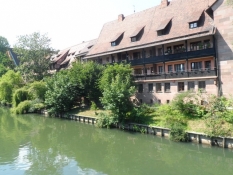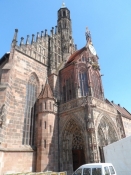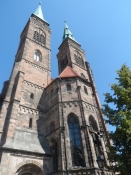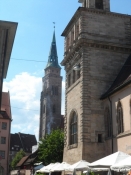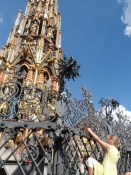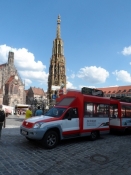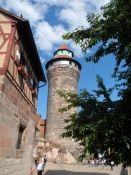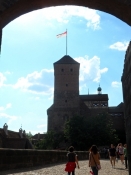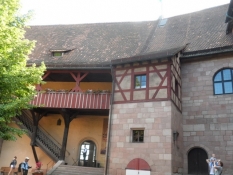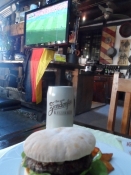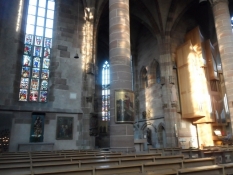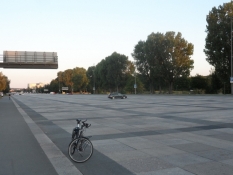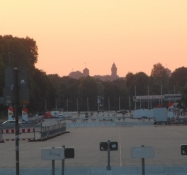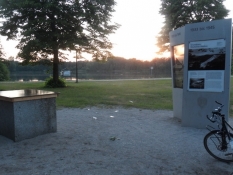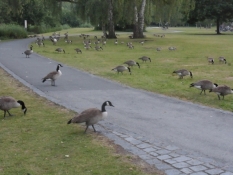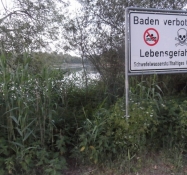Radtour Radelwoche in Franken und Bayern
Dag 3, hviledag/rest day: Nürnberg
![]()
Bitte warten - Kartendaten werden geladen
Erstellt am 07.07.2014
zuletzt geändert von Ottocolor am 27.08.2014
Strecken-Merkmale
gefahren
Gesamtlänge in km
21
Gesamthöhenmeter Aufstieg
213
Durchschn. Steigung Aufstieg %
1,01
Gesamthöhenmeter Abstieg
204
min. Höhe
311
max. Höhe
365
Informationen zu Rechten an den GPS-Track-Daten | |
|---|---|
Rechte-Inhaber | |
Rechte-Ausprägung / Lizenz | by-sa: CREATIVE COMMONS Namensnennung, Weitergabe unter gleichen Bedingungen |
Link zur Rechtebeschreibung | |
gpx-Datei hochgeladen | durch Ottocolor am 07.07.2014
|
Gesamtzahl Trackpoints
534
Trackpoint-Dichte per km
25
Endorte
Start
Nürnberg, Bayern, DE (326 m NHN)
Ziel
Nürnberg, Bayern, DE (325 m NHN)
gefahren am
18.06.2014
Wetter
Sunny again from early morning to late night and very warm. Almost no wind.
Unterkunft
KNAUS Campingpark Nürnberg
Hans-Kalb-Straße 56
DE-90471 Nürnberg
Beschaffenheit
Tarmac bike lanes on the former nazi party rally grounds. City roads all with bike lanes into the old city. There and up to the castle on the road partly with cobble stone surface.
Steigungs-Verteilung
Bemerkungen
Rest day of the bike week, the third day, spent in Nuremberg with two main parts, the former nazi party rally grounds, where the camp site also was and the old city with the castle.
Reisebericht
Informationen zu Urheber-Rechten | |
|---|---|
Rechte-Inhaber | |
Rechte-Ausprägung / Lizenz | by-sa: CREATIVE COMMONS Namensnennung, Weitergabe unter gleichen Bedingungen |
Link zur Rechtebeschreibung | |
Bild hochgeladen | durch Ottocolor am 11.07.2014
|
Informationen zu Urheber-Rechten | |
|---|---|
Rechte-Inhaber | |
Rechte-Ausprägung / Lizenz | by-sa: CREATIVE COMMONS Namensnennung, Weitergabe unter gleichen Bedingungen |
Link zur Rechtebeschreibung | |
Bild hochgeladen | durch Ottocolor am 11.07.2014
|
Informationen zu Urheber-Rechten | |
|---|---|
Rechte-Inhaber | |
Rechte-Ausprägung / Lizenz | by-sa: CREATIVE COMMONS Namensnennung, Weitergabe unter gleichen Bedingungen |
Link zur Rechtebeschreibung | |
Bild hochgeladen | durch Ottocolor am 11.07.2014
|
The best thing about the morning was that the sun was shining from a clear blue sky. Ah, it was great. Now I could dry my wet clothes. There was also a kind of dry-pavilion at the site, I wondered, no one else used it. Maybe it belonged to the caravan behind it, but these people were not at home, so it hardly mattered. After breakfast, which I had in a small square next to a goldfish pond, I went to camping daddy to register. And complain about the TV room being locked the night before. He seemed cold and bureaucratic, but instead of getting angry, I amused myself by his rigid shape. He belonged more to a secluded wing of the town hall or the police department for discarded numberplates. Then it was nicer to talk to an elderly Australian couple that I had pitched my tent next to. They were on their life's cycling tour from Amsterdam to Vienna. It's some distance, yes, but they had entire three months for it. So they moved through Central Europe at a snail's pace. And that's brilliant. Especially when you get so much out of it as at least the man did. They had been here in Nuremberg for a couple of days, and he had intercepted huge chunks of knowledge of the city in that time. Although I think I was pretty well informed in advance about what I wanted to see today, it was nothing compared to what this old chap had managed to download into his brain casket in a few days. I hope, he writes a travelogue in ten volumes, when he comes home 'down under'. I would love to read every part of it.
But time passed chatting, and now I myself wanted to experience Nuremberg and its both glorious and very checkered history. My first stop was peaceful enough, namely the neighbouring Grundig Arena. Well, not quite peaceful. Here 1 FC Nuremberg plays its home games, for them unfortunately now in the 2nd Bundesliga. And a little too sorry for me, because they were main relegation contender to my hate club Hamburger SV and obviously took all the relegation ticket instead. Having been almost half a season to win the first match, losing the last seven and gaining 3 points out of the last 36! It must go wrong. But the stadium is quite posh and was a venue during the World Cup in 2006 and is built in an octagonal shape, rather special. Built in 1925, it was already there when the Nazis began using this vast area to the mass scenes that were so masterfully staged in the film "Triumph des Willens" ("Triumph of the will") by director Leni Riefenstahl on the German Nazi party, NSDAP's, party congress in 1934. In this context, the stadium was used for gatherings of the party's youth organizations, respectively Hitler-Jugend for boys and BDM (Bund Deutscher Mädel) for the girls. The latter my mother had also been a member of. But here in Nuremberg, she had never been, and later, in the docu-center, I learned that only the elite were allowed to travel here, the so-called Nuremberg-travellers. And this elite it was indeed no shame not to belong to! After the war the stadium was aptly named Franconia Stadium. Now that Nuremberg is the capital of Franconia. Later, almost all stadiums received commercial names, named after a sponsor. This one was first given the rather stupid name Easy-Credit-Stadion. It got relatively soon rid of that and is now called Grundig Arena after the electronics group, resident in this city and founded by the renowned Max Grundig. In Danish 'grundig' means 'thorough'. German 'thoroughness', also in this explanation, right?
Informationen zu Urheber-Rechten | |
|---|---|
Rechte-Ausprägung / Lizenz | by-sa: CREATIVE COMMONS Namensnennung, Weitergabe unter gleichen Bedingungen |
Link zur Rechtebeschreibung | |
übernommen / bearbeitet am | 21.08.2014
|
übernommen / bearbeitet durch |
|
Informationen zu Urheber-Rechten | |
|---|---|
Rechte-Inhaber | |
Rechte-Ausprägung / Lizenz | by-sa: CREATIVE COMMONS Namensnennung, Weitergabe unter gleichen Bedingungen |
Link zur Rechtebeschreibung | |
Bild hochgeladen | durch Ottocolor am 11.07.2014
|
Informationen zu Urheber-Rechten | |
|---|---|
Rechte-Inhaber | |
Rechte-Ausprägung / Lizenz | by-sa: CREATIVE COMMONS Namensnennung, Weitergabe unter gleichen Bedingungen |
Link zur Rechtebeschreibung | |
Bild hochgeladen | durch Ottocolor am 11.07.2014
|
Informationen zu Urheber-Rechten | |
|---|---|
Rechte-Inhaber | |
Rechte-Ausprägung / Lizenz | by-sa: CREATIVE COMMONS Namensnennung, Weitergabe unter gleichen Bedingungen |
Link zur Rechtebeschreibung | |
Bild hochgeladen | durch Ottocolor am 11.07.2014
|
Informationen zu Urheber-Rechten | |
|---|---|
Rechte-Inhaber | |
Rechte-Ausprägung / Lizenz | by-sa: CREATIVE COMMONS Namensnennung, Weitergabe unter gleichen Bedingungen |
Link zur Rechtebeschreibung | |
Bild hochgeladen | durch Ottocolor am 11.07.2014
|
Informationen zu Urheber-Rechten | |
|---|---|
Rechte-Inhaber | |
Rechte-Ausprägung / Lizenz | by-sa: CREATIVE COMMONS Namensnennung, Weitergabe unter gleichen Bedingungen |
Link zur Rechtebeschreibung | |
Bild hochgeladen | durch Ottocolor am 11.07.2014
|
Informationen zu Urheber-Rechten | |
|---|---|
Rechte-Inhaber | |
Rechte-Ausprägung / Lizenz | by-sa: CREATIVE COMMONS Namensnennung, Weitergabe unter gleichen Bedingungen |
Link zur Rechtebeschreibung | |
Bild hochgeladen | durch Ottocolor am 11.07.2014
|
This municipal stadium was only a minor fraction of the Nazi Party rally area, which in large parts still exists. The central arena of the mass assembly of people were the zeppelin-field, which is derelict, but still exists in some of its original volume and the Luitpold Arena, which I did not get to see. I concentrated on the zeppelin-field. Here Hitler held his flaming, hateful speeches during the party rallies from the pulpit on the main tribune. The speech was the central element of the grandiose self-promotion, which in turn was a key part of the Nazis' success in seducing the German people and, incidentally, a good part of the rest of the world, including British and Danish leaders. The participants on the spot were supposed to feel part of something unique large, and by way of radio and documentary films (I have already mentioned Leni Riefenstahl), this greatness was transmitted out and into every single German home. Before I visited the main grandstand, I went over to the zeppelin-field's staging area. It had been fenced off, because they were getting ready to arrange the annual car race of Noris-Ring, which has its finishline opposite the main grandstand. The nazi deployment area was now used as parking for large trucks, so it was a little difficult to imagine that here up to 300,000 people had acclaimed the "fuehrer" on the rostrum. The sides had low towers, which helped to create an atmosphere of regularity and order. Now the concrete was crumbling and tall weeds growing up them. The same was true of the large main grandstand, which I walked up afterwards. There were lots of barriers set up for the motor race and workers put up temporary steel stands, speaker towers and other equipment, but I was allowed to just climb a barrier in order to mount the podium. Again all the modern motorsports equipment made it hard to imagine myself attending a Nazi party rally today, but on the other hand I was as lucky that the Noris-Ring car race wasn't to be staged this weekend. So I managed to make it to the top where the giant kollonnade had stood. On top of it a row of powerful spotlights had shone straight up into the sky and created the so-called light-cathedral. On the high corner towers that had been blasted along with the kollonnades in the 60s because they were about to collapse, there had been great fire bowls. One was used as a childen's børnesoppebassin in stadium-outdoor pool, but has now returned and standing in front of the tribune's main entrance. When I finished staring at the zeppelin-field, I found my bike and cycled around the Dutzend dam along the same route that I had come cycling in the rain the evening before. Now the sun was shining as it did throughout the day. Super Lucky. Now my goal was the huge convention hall on the other side of the pond. The Nazis had built it from scratch on marshy ground, so it needed enormous foundation works, but it was, like much else here, far from being finished. When the second world war broke out in September 1939 all construction activity stopped and the party rallies were also set. What was left were the half-finished buildings. The Congress Hall where I put my bike and initially went into the courtyard, was to be covered and covered with lime shell inside and outside. In the courtyard there were some good posters that showed how the plans had been. Up above my head a long steel walk stuck out above the courtyard. It came out of the hall's side like a long spear. There were people up there, I could see. It later turned out to belong to the documentation center of the nazi party rally area which I wanted to visit afterwards. On the other side it continued to "spit" out of the wall, and it can also be found inside the building. It symbolizes the hole that was speared 'through the Nazi ideology, so that the seduction of the German people had folkeforføringen ultimately failed and was speared by our modern democracy. But it took military force and millions of deaths before it came to this. Now I would go inside and learn about how the Nazis had planned to deceive the Germans into believing their sick ideology and why they managed to do it within a few years. Megalomania was one of the funds. People like to feel small and as a pawn in a large, well-ordered whole. Virtually in all religions this is an essential feature. It is no different in St. Peter's Square in Rome, where the Pope appears on the balcony of St. Peter's Cathedral. The content of the speeches made at Nuremberg was completely different, but the form is directly comparable. Size plays without doubt a major role. 'Size matters', one could say with a modern expression.
Informationen zu Urheber-Rechten | |
|---|---|
Rechte-Ausprägung / Lizenz | by-sa: CREATIVE COMMONS Namensnennung, Weitergabe unter gleichen Bedingungen |
Link zur Rechtebeschreibung | |
übernommen / bearbeitet am | 23.08.2014 - 24.08.2014
|
übernommen / bearbeitet durch |
|
Informationen zu Urheber-Rechten | |
|---|---|
Rechte-Inhaber | |
Rechte-Ausprägung / Lizenz | by-sa: CREATIVE COMMONS Namensnennung, Weitergabe unter gleichen Bedingungen |
Link zur Rechtebeschreibung | |
Bild hochgeladen | durch Ottocolor am 11.07.2014
|
Informationen zu Urheber-Rechten | |
|---|---|
Rechte-Inhaber | |
Rechte-Ausprägung / Lizenz | by-sa: CREATIVE COMMONS Namensnennung, Weitergabe unter gleichen Bedingungen |
Link zur Rechtebeschreibung | |
Bild hochgeladen | durch Ottocolor am 11.07.2014
|
Informationen zu Urheber-Rechten | |
|---|---|
Rechte-Inhaber | |
Rechte-Ausprägung / Lizenz | by-sa: CREATIVE COMMONS Namensnennung, Weitergabe unter gleichen Bedingungen |
Link zur Rechtebeschreibung | |
Bild hochgeladen | durch Ottocolor am 11.07.2014
|
Inside the convention hall was only an empty shell and all the walls were just raw bricks. The documentation centre occupied only a small corner of it and apart from it and a small part of the opposite end wing, occupied by the local symphony orchestra, the huge building was empty. On the outside the facade had been covered with mussel limestone and it looks really quite impressive. It was meant to illude the Coliseum in Rome. But the illusion collapses totally in the courtyard and inside the building. The docu centre offered free audio guides, making it possible to choose which items on the Nazi consolidation of power, one wanted to plunge into. The period 1933-39, ie up to the outbreak of the war, was in focus here. I chose to immerse myself into the creation of the Fuehrer cult, that is how Adolf Hitler was made into an infallible leader depriving his people of any own initiative and influence on their own destiny. The German people was the chosen one. An idea similar to the profecy from the Old Testament about the Jewish people. As was precisely the main opponent of the Nazis. These ideas consisted the national ones in the term national socialist. The socialist ones consisted of the individual's total subordination to the masses. Except, a single individual, namely Hitler. The economy wasn ot meant to turn socialist. Thus the large industrial groups such as Krupp retained their influence. In the twenties there had been strong socialist forces in the Nazi Party, but they had been out-maneuvered by Hitler and his clique. In January 1933 the aged President Hindenburg appointed Hitler chancellor, mostly in the absence of other suitable candidates, and when he died in the year after, Hitler joined the presidential power with the governmental and called himself now Fuehrer (leader) and chancellor. Now his formal power base was created and then followed a systematic repression of any opposition. At the same time the new rulers legitimized themselves by the one idea that Hilter, as another Moses, would lead the chosen people into the promised land. That this land was to be in the East, Hitler made no secret of. But before that could happen, the country had to be subjected and militarized. Militarism plays an important role in Germany, and has done so for centuries. The military circle's humiliation after World War I Hitler use very astutely in his power consolidation. Until he, during the war, when he was dubbed Gröfaz (größter Feldherr aller Zeiten, "the all-time greatest general"), no longer seemed to need his generals. The party rallies here in Nuremberg played a central role in the consolidation of Nazi Germany, or the Third Reich, as the Nazi empire saw itself as, ie a successor to the Holy Roman Empire of the Middle Ages and the German Empire of 1871. As Nuremberg was one of the most important cities in the medieval kingdom with its large intact imperial castle towering over the city it was chosen as' city of the Reich's party rallies', as it has since been dubbed. Berlin was of course the capital and Munich the 'capital of the movement'. Vienna and Linz were also to be called "Fuehrer" cities, mostly because of Hitler's personal originating from here. While most of the plans stayed plans in other cities, a lot of them were executed here in Nuremberg. And now I moved around in one of the buildings, Hitler's dream of restoring the Colosseum. The outcome of megalomania and militarization, the devastating war for 'Lebensraum' in the East, is not a subject in this docu-center. However, very symbolic when you walk down a flight of stairs towards the end, you walk towards a giant photostat showing the bombed Nuremberg after the war. Hardly a house is unharmed, as was the case in all major and many of the medium-sized German cities. In 1933, Hitler had said: "Give me ten years and you will not recognize Germany". Here he was really sadly right, you might say. Apart from the fact that his millennial empire did not last ten but twelve years. Eventually, I walked out the 'spear' through the Congress Hall, and thus stood on the floating steel walk high above the courtyard, where I had stood before. Within the building the steel walk ran along a railway track, symbolizing the railway to the Auschwitz extermination camp in Poland, which came to stand as the symbol of the Nazi inhumanity. On the trail were small patches with names. Every one name stood for 60,000 murdered people. I do not remember why this figure was used, but it is the population of an ordinary medium-sized city. And there was insanely many patches with names on the railway track. This 'spear' through Congress Hall, which can also be seen as an image of the militaristic rape of the German people during the Nazi era, naturally led down into the hall, where I returned my audio guide. Now I longed to leave this dark building and this dark chapter in German history, a country I very much identify myself with qua my background with a German mother and a Danish father who had volunteered for Hitler's war in 1944. Personally I believe that even if it certainly happened in Germany it could have happened elsewhere too. Germany is equally a perpetrator and a victim of the Nazi madness. And Hitler too was only a specimen of the species homo sapiens, as we all are. So in this respect, we are all responsible for what happened in the years 1933 to 1945, also we Danes, who otherwise prefer to see ourselves solely as victims.
But now it's enough, and I stumbled out into the sun, which shone from a cloudless sky today. As if it had never rained. And the old Nuremberg looked so charming as if it had never been abused outrageously and had never been completely smashed by the Allied bombs beyond recognition. At first I however stayed at the shores of the big Dutzend-Teich, as I had passed a lovely beer garden, Gutmann, in the opposite corner of the convention hall. Here I had a portion of genuine Nuremberg fried sausages with potato salad and a liter of beer. The beer garden was well attended, but I noticed that very few guests had ordered a 'Mass' of beer, that is a liter. I concluded from that that the Franks's are not as good beerdrinkers as the Bavarians. In Munich you make a weak piddler out of yourself, if you sit with nothing less than a liter mug of a beer in a city beer garden. But the beer tasted well enough. It was Gutmann's own brew from their brewery in Titting not far from Nuremberg. After lunch I cycled into the center. Now I wanted to have a look of it in the sunshine, I had rushed by in the rain the evening before.
Informationen zu Urheber-Rechten | |
|---|---|
Rechte-Ausprägung / Lizenz | by-sa: CREATIVE COMMONS Namensnennung, Weitergabe unter gleichen Bedingungen |
Link zur Rechtebeschreibung | |
übernommen / bearbeitet am | 25.08.2014
|
übernommen / bearbeitet durch |
|
Informationen zu Urheber-Rechten | |
|---|---|
Rechte-Inhaber | |
Rechte-Ausprägung / Lizenz | by-sa: CREATIVE COMMONS Namensnennung, Weitergabe unter gleichen Bedingungen |
Link zur Rechtebeschreibung | |
Bild hochgeladen | durch Ottocolor am 11.07.2014
|
Informationen zu Urheber-Rechten | |
|---|---|
Rechte-Inhaber | |
Rechte-Ausprägung / Lizenz | by-sa: CREATIVE COMMONS Namensnennung, Weitergabe unter gleichen Bedingungen |
Link zur Rechtebeschreibung | |
Bild hochgeladen | durch Ottocolor am 11.07.2014
|
Informationen zu Urheber-Rechten | |
|---|---|
Rechte-Inhaber | |
Rechte-Ausprägung / Lizenz | by-sa: CREATIVE COMMONS Namensnennung, Weitergabe unter gleichen Bedingungen |
Link zur Rechtebeschreibung | |
Bild hochgeladen | durch Ottocolor am 11.07.2014
|
Informationen zu Urheber-Rechten | |
|---|---|
Rechte-Inhaber | |
Rechte-Ausprägung / Lizenz | by-sa: CREATIVE COMMONS Namensnennung, Weitergabe unter gleichen Bedingungen |
Link zur Rechtebeschreibung | |
Bild hochgeladen | durch Ottocolor am 11.07.2014
|
Informationen zu Urheber-Rechten | |
|---|---|
Rechte-Inhaber | |
Rechte-Ausprägung / Lizenz | by-sa: CREATIVE COMMONS Namensnennung, Weitergabe unter gleichen Bedingungen |
Link zur Rechtebeschreibung | |
Bild hochgeladen | durch Ottocolor am 11.07.2014
|
Informationen zu Urheber-Rechten | |
|---|---|
Rechte-Inhaber | |
Rechte-Ausprägung / Lizenz | by-sa: CREATIVE COMMONS Namensnennung, Weitergabe unter gleichen Bedingungen |
Link zur Rechtebeschreibung | |
Bild hochgeladen | durch Ottocolor am 11.07.2014
|
Informationen zu Urheber-Rechten | |
|---|---|
Rechte-Inhaber | |
Rechte-Ausprägung / Lizenz | by-sa: CREATIVE COMMONS Namensnennung, Weitergabe unter gleichen Bedingungen |
Link zur Rechtebeschreibung | |
Bild hochgeladen | durch Ottocolor am 11.07.2014
|
Informationen zu Urheber-Rechten | |
|---|---|
Rechte-Inhaber | |
Rechte-Ausprägung / Lizenz | by-sa: CREATIVE COMMONS Namensnennung, Weitergabe unter gleichen Bedingungen |
Link zur Rechtebeschreibung | |
Bild hochgeladen | durch Ottocolor am 11.07.2014
|
Initially I concentrated on the area down to the river Pegnitz. Here stands the hospital of the holy ghost, one of the numerous medieval buildings in Nuremberg, which were completely destroyed during the many Allied bombings of the city at the end of WW2, and which were subsequently rebuilt in its original form. Here as elsewhere additions that had been made in the era of historicism were omitted, ie. the second half of the 19th century, when the idea was to recreate the Middle Ages in the imagination of that time and of course from the Nazi period, when another glorification of the Middle Ages was held high. And nowhere was this more evident than here in Nuremberg. The city was, next to Rome, a sort of capital of the Holy Roman Empire, at least in the German part of it and second in size here only to Cologne. Many of the emperors stayed for long periods and here the crown jewels, ie the crown, the scepter and orb were kept, right here in the hospital of the holy ghost. Why they were not placed up in the castle is really inexplicable, because you would think they were much safer up there. It was great to roll slowly around the center of the old city and enjoy the many old houses. It was quite incredible to think they almost all had been rebuilt after the war. But when you know that 90% of the center lay in ruins, it had to be true. Eventually I ended up back on the big main marketplace. Here the Jewish quarter had once been, but after a pogrom, that is, a violent persecution in the Middle Ages, it was demolished and the square was placed here. It is located about midway between the two boroughs of Sebald to the north and Lorenz to the south, each having their main church. The main attraction on the square is "The beautiful well" from the 1300s. It looks like the tip of a Gothic church and tells in four stories about the world of the Holy Roman Empire with all the important people included as colourful figures. The well in the marketplace is a copy, while the real one stands in the Germanisches National Museum here in town, ie the Germanic National Museum. As Germany, because of its fractured history has no museum of the German nation, this museum could be considered to be Germany's national museum. The Germanic peoples may well be regarded as the predecessors of the modern German people. In the market place beside the well stood a small tourist train, which was soon to leave for a tour of the city centre. I had preferred a real guided tour, but the last one had left, and it was a good opportunity to get an overview of the sights of Nuremberg's old town. We drove along the so-called "historical mile" along which the major attractions are located. First the train, pulled by a locomotive shaped car pootled up to the castle. I would certainly visit that later. The train went around it, and then I could see it from the north side too. The explanations were not particularly exciting, but as I did not know that much about the city, they offered a good overview. And I just had no time to immerse deeper into it this time. Back on the main market square, I found my bike and took well to the pedals to get up the cobbles to the imperial castle on the rocky mountain of Nuorenberc, which has given the city name. Today the inhabitants mock the city by saying "nur'n Berg" (only a mountain). At the entrance to the castle is the tavern Burgwachter (castle guard), where I parked my treadmill. At the entrance they advertised with the "all World Cup matches directly". Fine. I had just found the place where I would have dinner. And watch football. And drink beer. Well, it's three things, and they go really fine along. But first, an appropriate portion of culture and history at the castle. It turned out that it covers a very large area, so I wanted to concentrate on the Imperial castle to the west. Slowly I walked past the Sinwell tower, which is round with a conical roof and the so-called 'deep-well'. It was so deep that the castle withstood sieges very long time. There was also a terrace with a beautiful view over the old town. I could easily spot the congress hall and the stadium, 4-5 km to the southeast. Most westerly stands the Imperial Palace, where I stopped to rest outside the building. Here a nice and quiet atmosphere reigned and I tried to imagine life in the Middle Ages. Then I went out in the square behind the palace. On the wall I looked down at the moat, where a beer festival was going on. I had read about it, but history and the World Cup made me opt it out at the cost of the city and the restaurant at the foot of the castle. Now I walked down there past a lot of people who apparently were to celebrate a fine feast at the castle. They were certainly dressed festively. There is also a very large hostel up here. It certainly has a great location. Perhaps I should stay there sometime and see more of this beautiful city with its beautiful well. And the magnificent and the checkered history. And it Germanic National Museum. But right now there were the three things at the restaurant Burgwaechter.
Informationen zu Urheber-Rechten | |
|---|---|
Rechte-Ausprägung / Lizenz | by-sa: CREATIVE COMMONS Namensnennung, Weitergabe unter gleichen Bedingungen |
Link zur Rechtebeschreibung | |
übernommen / bearbeitet am | 25.08.2014 - 26.08.2014
|
übernommen / bearbeitet durch |
|
Informationen zu Urheber-Rechten | |
|---|---|
Rechte-Inhaber | |
Rechte-Ausprägung / Lizenz | by-sa: CREATIVE COMMONS Namensnennung, Weitergabe unter gleichen Bedingungen |
Link zur Rechtebeschreibung | |
Bild hochgeladen | durch Ottocolor am 11.07.2014
|
Informationen zu Urheber-Rechten | |
|---|---|
Rechte-Inhaber | |
Rechte-Ausprägung / Lizenz | by-sa: CREATIVE COMMONS Namensnennung, Weitergabe unter gleichen Bedingungen |
Link zur Rechtebeschreibung | |
Bild hochgeladen | durch Ottocolor am 11.07.2014
|
Informationen zu Urheber-Rechten | |
|---|---|
Rechte-Inhaber | |
Rechte-Ausprägung / Lizenz | by-sa: CREATIVE COMMONS Namensnennung, Weitergabe unter gleichen Bedingungen |
Link zur Rechtebeschreibung | |
Bild hochgeladen | durch Ottocolor am 11.07.2014
|
Now I looked forward to sit down and enjoy the culture of the castle guard's restaurant. The tables were in a room outside the restaurant itself, but were covered by a large sunshade and I positioned myself where I had good view of the big screen. There was some time before the World Cup match Netherlands versus Australia was to start, so I enjoyed a pint of another local beer brand from Zirndorf. The restaurant was almost empty, but before the match started, it was nearly full, so it had been right to come in good time. The match got underway and was much more exciting than expected as the Australians held against and scored a dream goal. Eventually the Dutch won, however, expectedly 3-2. Along with the football and the beer I had a good burger with accessories. It was the house specialty, and you could see the chef work in the back, where the food sizzled in the pan. A good way to create expectations out of the restaurant, when you can see and hear a little of the stuff you soon will put your teeth into. After dinner it was still warm and sunny, and I wanted to do some more sigthseeing. First more of the old town.
Informationen zu Urheber-Rechten | |
|---|---|
Rechte-Ausprägung / Lizenz | by-sa: CREATIVE COMMONS Namensnennung, Weitergabe unter gleichen Bedingungen |
Link zur Rechtebeschreibung | |
übernommen / bearbeitet am | 26.08.2014 - 27.08.2014
|
übernommen / bearbeitet durch |
|
Informationen zu Urheber-Rechten | |
|---|---|
Rechte-Inhaber | |
Rechte-Ausprägung / Lizenz | by-sa: CREATIVE COMMONS Namensnennung, Weitergabe unter gleichen Bedingungen |
Link zur Rechtebeschreibung | |
Bild hochgeladen | durch Ottocolor am 11.07.2014
|
Informationen zu Urheber-Rechten | |
|---|---|
Rechte-Inhaber | |
Rechte-Ausprägung / Lizenz | by-sa: CREATIVE COMMONS Namensnennung, Weitergabe unter gleichen Bedingungen |
Link zur Rechtebeschreibung | |
Bild hochgeladen | durch Ottocolor am 11.07.2014
|
Informationen zu Urheber-Rechten | |
|---|---|
Rechte-Inhaber | |
Rechte-Ausprägung / Lizenz | by-sa: CREATIVE COMMONS Namensnennung, Weitergabe unter gleichen Bedingungen |
Link zur Rechtebeschreibung | |
Bild hochgeladen | durch Ottocolor am 11.07.2014
|
Informationen zu Urheber-Rechten | |
|---|---|
Rechte-Inhaber | |
Rechte-Ausprägung / Lizenz | by-sa: CREATIVE COMMONS Namensnennung, Weitergabe unter gleichen Bedingungen |
Link zur Rechtebeschreibung | |
Bild hochgeladen | durch Ottocolor am 11.07.2014
|
Informationen zu Urheber-Rechten | |
|---|---|
Rechte-Inhaber | |
Rechte-Ausprägung / Lizenz | by-sa: CREATIVE COMMONS Namensnennung, Weitergabe unter gleichen Bedingungen |
Link zur Rechtebeschreibung | |
Bild hochgeladen | durch Ottocolor am 11.07.2014
|
Informationen zu Urheber-Rechten | |
|---|---|
Rechte-Inhaber | |
Rechte-Ausprägung / Lizenz | by-sa: CREATIVE COMMONS Namensnennung, Weitergabe unter gleichen Bedingungen |
Link zur Rechtebeschreibung | |
Bild hochgeladen | durch Ottocolor am 11.07.2014
|
First I rolled down to the beautiful church on the Main Market, I had noticed there. And I was lucky, it was stille open. This was the Frauenkirche, Our Lady's Church, a Gothic basilica from the 1350s, which today is home to a Catholic congregation. It was built shortly after the Great pogrome against jeg Jews which resulted in the synagogue's demolition, so there was room for the church. The church is richly decorated, and this is obvious, as it often served as an imperial court chapel and the crown jewels were sometimes on display here. I was not allowed to stay long, as the organist, who had been playing, wished to shut the door immediately after his job. Of course, I understood that very well, in fact I was really happy to have managed to see it from the inside. After the visit to the Frauenkirche I rode my bicycle to the Reichs party rally area again. But this time I turned right at the congress hall. Thus I came to the starting point of the so-called Große Straße ("The Great Road"). It starts off the congress hall's front portal, where the city's party square today lies. Later in the summer they held the big city festival here. From here "the large road" which the Nazis built as a road for mass parades, in a southeasterly direction. It is 60 meters wide and covered with granite tiles in different colors. This was to make it easier to march in rows and keep the ranks together during the mass parades of Wehrmacht soldiers, reich labor service officials, young people from the Hitler Youth and the BDM and an army of party soldiers. As mentioned, the militarization of Germany, especially of the youth, was central under Hitler. Today it is used primarily as a parking space. It is possible to cycle along it, but you must beware of the many steel barriers that make it easier to find a parking space and not least ones car again afterwards because it's definetly not easy to find on the colossal road. Farther out, I passed the campsite to the left, but wanted to ride all the way to the end. To the right many new buildings with a lot of steel and glass facades were built. This was Nuremberg's new exhibition center. It also used the Nazi road as a car park. On the outer edges of the road was a driving lane in each direction and even further out at the edges some pretty dilapidated low grandstands from which spectators could attend the Nazi parades. When I came right up to the end of the road I turned round towards the city and it was clear that it was directed towards the imperial castle that towered above the city centre in the distance. It was Hitler's architect Albert Speer, who had secured this. It was meant to symbolize the Third Reich's cohesion with the first one, that is the medieval Reich. Now I lacked only to see one thing in the party rally area, and that was really nothing, namely the huge Deutsches Stadion ("German Stadium"), which, apart from excavations for the foundation, was never built. It was again Speer, who had been in Athens and seen the horseshoe-shaped Panathinaiko Stadium there. It was supposed to be the world's largest stadium and form the setting for the Olympic Games (like the Athenian model had done in 1896). In 1936, the games were held in Berlin, but Hitler wanted all future Olympic Games after 1940, when they were scheduled in Tokyo, to be held here in the Deutsches Stadion in Nuremberg. The foundation stone was laid in September 1937 and the opening was scheduled for 1945. You may then ask, where the Games in 1944 were to be held? I do not know. But the war put an end to both the construction works and the Olympics, and the excavation was soon filled with groundwater, which now forms the lake Silbersee in a beautiful park. The foundation stone is the only thing to be seen of the Deutsches Stadion here, but on a hillside outside the town a wooden model of a stand in the original size, and there you can still see the posts' foundations. After the war, long before the idea of laying out a park here, the city used Silbersee as a dump, in the first place for the huge amounts of rubble from the totally destroyed city centre, later also for household waste and hazardous toxic waste. It was just poured into the lake and into the 350 m high hill, which was formed next to it, and which is a viewing point overlooking the area today. Unfortunately, the toxic waste made the lake heavily contaminated with hydrogen sulphide. Still today,it represents a great danger, and large signs along the lake tell that it is forbidden and dangerous to swim in it. Still, more than 60 people have died after contact with the toxic water. And many more have become ill. A big problem is also the fact that the groundwater stands very high here and mixes with the lake's toxic content. The problem is too large for Nuremberg city to solve it alone, and a solution is not in sight. I biked around the lake with the beautiful name, and where an immensely romantic atmosphere reigned on such a beautiful sunshine summer evening. Canada geese were waddling across the paths. They swam calmly around the lake. But they could probably not read the signs! On the way back to the campsite I cycled up the Silberbuck as the waste-viewing hill is called. But a lot of greenery did now allow the view to be spectacular. It was getting dark anyway, so I chose to slip down through the exhibition area and the "Große Straße" to the campsite. This day had passed and I was also very tired. The TV room was still locked, even if Spain played football against Chile in Brazil. I slipped into my sleeping bag and let them play and was later told that Spain, the reigning world champion, had lost 0-2 and was eliminated from the World Cup. Caramba!
Informationen zu Urheber-Rechten | |
|---|---|
Rechte-Ausprägung / Lizenz | by-sa: CREATIVE COMMONS Namensnennung, Weitergabe unter gleichen Bedingungen |
Link zur Rechtebeschreibung | |
übernommen / bearbeitet am | 27.08.2014
|
übernommen / bearbeitet durch |
|

